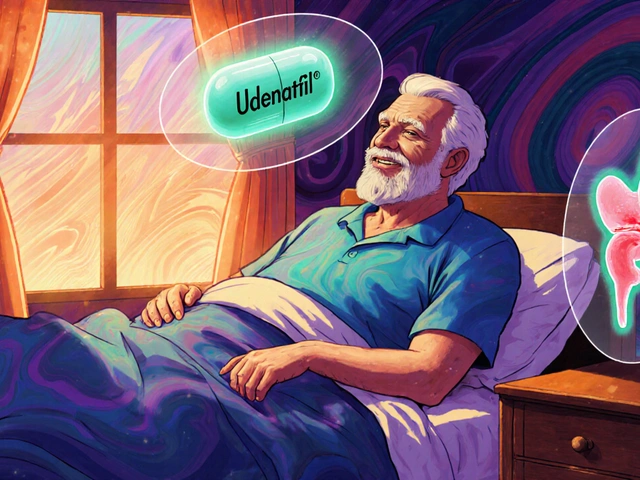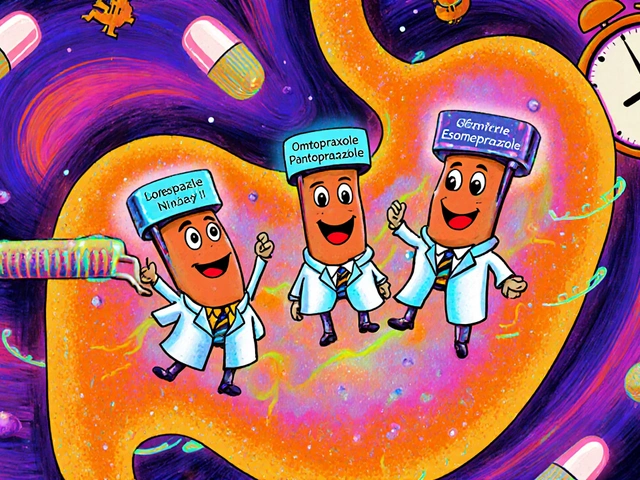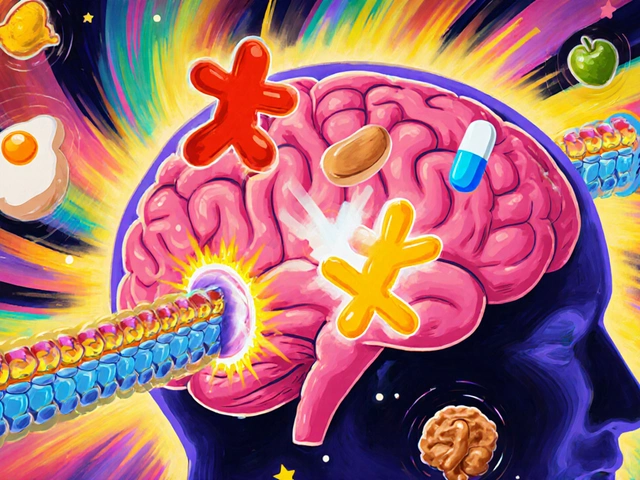Anemia Knowledge Quiz
1. What is the primary function of red blood cells in relation to anemia?
2. Which of the following is NOT a common symptom of anemia?
3. What is the most common type of anemia?
4. Which nutrient deficiency commonly leads to anemia?
5. What is a typical treatment for vitamin B12 deficiency anemia?
Key Takeaways
- Anemia means your blood can’t carry enough oxygen.
- Iron deficiency, vitamin B12 lack, and chronic disease are the top culprits.
- Common signs include fatigue, pale skin, shortness of breath, and unusual cravings.
- Blood tests confirm the diagnosis; treatment ranges from supplements to transfusions.
- Lifestyle tweaks-diet, exercise, and managing underlying conditions-keep anemia at bay.
What Exactly Is Anemia is a condition where the blood lacks enough healthy red blood cells or hemoglobin to transport sufficient oxygen to the body’s tissues?
Think of your blood as a delivery truck. If the truck is short on cargo (red blood cells) or the driver (hemoglobin) is weak, your organs don’t get the oxygen they need. That shortage shows up as everyday fatigue, brain fog, or that funny feeling when you climb a flight of stairs.
While the term sounds medical, anyone can experience it-especially women of childbearing age, athletes, and people with chronic illnesses.
Major Causes: Why Does Anemia Happen?
The reasons fall into three buckets: reduced production, increased loss, or accelerated destruction of red blood cells.
1. Reduced Production
When your body can’t make enough red blood cells, you typically see one of these disorders:
- Iron‑deficiency anemia is the most common form, caused by inadequate iron intake, poor absorption, or chronic blood loss.
- Vitamin B12 deficiency anemia is often linked to pernicious anemia or dietary restrictions like veganism.
- Folate deficiency anemia is common in pregnancy and with certain medications.
2. Increased Loss
Blood loss can be obvious (injury, surgery) or hidden (heavy periods, gastrointestinal bleeding). Chronic bleeding drains iron stores, eventually leading to iron‑deficiency anemia.
3. Accelerated Destruction
Some conditions cause red blood cells to break down faster than they’re replaced:
- Sickle cell anemia is an inherited disorder where malformed hemoglobin makes red cells rigid and prone to rupture.
- Autoimmune hemolytic anemia, where the immune system mistakenly attacks red cells.
Spotting the Symptoms: How Do You Know You Might Have Anemia?
Symptoms can be subtle at first, especially if the drop in hemoglobin is gradual. Keep an eye out for:
- Persistent fatigue or weakness that doesn’t improve with rest.
- Pale or yellowish skin, especially around the lips and nail beds.
- Shortness of breath during routine activities.
- Rapid heartbeat or palpitations.
- Headaches, dizziness, or difficulty concentrating.
- Strange cravings for ice, dirt, or starch (known as pica).
- Cold hands and feet.
If you notice a cluster of these signs, it’s worth chatting with a GP.
Getting a Diagnosis: Which Tests Pinpoint Anemia?
Doctors rely on a few key blood tests:
- Complete blood count (CBC) measures hemoglobin level, hematocrit, and red blood cell count.
- Serum ferritin to assess iron stores.
- Vitamin B12 and folate levels for deficiency checks.
- Reticulocyte count to see how fast bone marrow is producing new red cells.
- Peripheral smear for visual inspection of cell shape (helps identify sickle cells).
When results point to a specific deficiency, the treatment plan becomes clearer.

Treatment Options: From Supplements to Transfusions
How you treat anemia depends on its root cause.
Iron‑Deficiency Anemia
First‑line therapy is oral iron supplements-typically ferrous sulfate, gluconate, or fumarate. Take them on an empty stomach for better absorption, but if stomach upset occurs, a small snack is fine.
Diet matters, too. Include iron‑rich foods like lean red meat, lentils, spinach, and fortified cereals. Pairing iron with vitamin C (orange juice, bell peppers) boosts absorption.
Vitamin B12 or Folate Deficiency
Injections of cyanocobalamin or high‑dose oral tablets resolve B12 gaps quickly. Folate deficiency is treated with folic acid tablets, and pregnant women often need a prenatal supplement that covers both.
Chronic Disease‑Related Anemia
If inflammation from conditions like rheumatoid arthritis or chronic kidney disease is the trigger, managing the underlying disease is key. Sometimes, erythropoiesis‑stimulating agents (ESAs) are prescribed to nudge the bone marrow.
Severe Cases
When hemoglobin falls below 7‑8g/dL or symptoms are life‑threatening, a blood transfusion is the fastest way to restore oxygen‑carrying capacity. It’s a short‑term fix while the underlying issue is addressed.
Monitoring Progress
Follow‑up CBCs every 2‑4 weeks gauge improvement. If iron levels plateau, consider checking for hidden bleeding (e.g., gastrointestinal ulcer).
Lifestyle & Prevention: Keeping Anemia at Bay
Even after treatment, long‑term habits keep red blood cells healthy.
- Eat a balanced diet rich in heme iron (meat) and non‑heme iron (beans, nuts) plus vitamin C.
- Limit coffee or tea around meal times; tannins hinder iron absorption.
- Regular exercise boosts circulation and stimulates bone‑marrow activity.
- Women with heavy menstrual flow might benefit from a gynecologist’s evaluation or hormonal therapy.
- Screen for anemia during pregnancy; iron needs rise dramatically.
Remember, treating anemia isn’t just about popping pills-it’s about addressing the whole picture.
When to Seek Immediate Help
If you experience any of these, call emergency services or head to A&E:
- Chest pain or severe shortness of breath.
- Dizziness that leads to fainting.
- Rapid heart rate (over 100bpm) at rest.
- Sudden, unexplained bruising or bleeding.
These signs may indicate a critical drop in oxygen delivery.
Comparison of Common Anemia Types
| Type | Primary Cause | Typical Hemoglobin (g/dL) | Common Symptoms | First‑Line Treatment |
|---|---|---|---|---|
| Iron‑deficiency | Inadequate iron intake or loss | 8‑11 | Fatigue, pica, brittle nails | Oral iron + dietary changes |
| Vitamin B12 deficiency | Pernicious anemia or malabsorption | 8‑10 | Numbness, tingling, memory loss | Intramuscular B12 injections |
| Sickle cell | Inherited abnormal hemoglobin | 6‑9 | Pain crises, jaundice | Hydroxyurea, blood transfusions |
| Anemia of chronic disease | Inflammation‑driven iron sequestration | 9‑12 | General fatigue, mild dyspnea | Treat underlying disease, ESAs |
Quick Recap
Understanding anemia starts with recognizing the low‑oxygen warning signs, getting the right blood tests, and then tackling the specific cause-whether that’s a simple iron boost or a more complex medical regimen. With the right diagnosis and a tailored plan, most people bounce back to feeling energetic and healthy.
Frequently Asked Questions
Can anemia be cured permanently?
If the underlying cause is reversible-like dietary iron deficiency-then yes, correcting the deficiency can lead to lasting remission. For genetic forms (e.g., sickle cell) or chronic‑disease anemia, management is ongoing, but symptoms can be kept in check with treatment.
How long does it take for iron supplements to raise hemoglobin?
Most people see a measurable rise in hemoglobin within 2‑4 weeks, but full normalization may take 2‑3 months of consistent supplementation.
Is it safe to take iron pills with coffee?
Not really. Tannins in coffee bind iron and reduce absorption by up to 60%. It’s best to separate iron intake and coffee by at least an hour.
Why do some people crave ice when they’re anemic?
The craving, called pica, may stem from the body’s attempt to stimulate alertness or from a neurological response to low oxygen. Ice chewing can also temporarily increase alertness, masking fatigue.
Can pregnancy cause anemia?
Yes. Blood volume expands by about 50% during pregnancy, diluting red cells. Plus, the growing fetus needs iron, so many pregnant women develop iron‑deficiency anemia if they don’t supplement.





Jennifer Ramos
September 29, 2025 AT 14:05Great overview! I love how the guide breaks down the different causes of anemia and gives clear pointers on what to look for in symptoms. 😊 It really helps anyone trying to figure out if they need to get checked. Also, the treatment section is super practical – diet tips, supplement advice, and when to see a doctor. Keep up the good work!
-
Grover Walters
October 5, 2025 AT 09:16It is noteworthy that anemia, despite its prevalence, is often overlooked in routine health assessments. The physiological imperative of hemoglobin transport underpins much of what we observe clinically, and a deficiency can manifest subtly. Consequently, the inclusion of a diagnostic quiz is pedagogically sound, encouraging self‑assessment prior to professional consultation.
Keiber Marquez
October 11, 2025 AT 04:26Yo, this article got the basics right but some parts r kinda messy. Iron‑deficiency is the big one, u know? And you gotta eat more red meat or beans. Also, watch out for the weird spelling errors – they made me lol.
Lily Saeli
October 16, 2025 AT 23:36People need to understand that ignoring anemia is morally negligent. The body is a temple, and depriving it of proper oxygen is a form of self‑harm. Simple steps like iron‑rich foods and proper medical follow‑up are not optional; they are ethical obligations.
Joshua Brown
October 22, 2025 AT 18:46For anyone dealing with anemia, start with a complete blood count to confirm the diagnosis, then assess ferritin levels to differentiate iron‑deficiency from other causes. If iron‑deficiency is confirmed, a typical regimen includes 325 mg ferrous sulfate orally twice daily, taken with vitamin C to enhance absorption, and preferably on an empty stomach. Monitor hemoglobin weekly for the first two weeks, then monthly thereafter. If the patient cannot tolerate oral iron, consider intravenous iron sucrose or ferric gluconate. For vitamin B12 deficiency, intramuscular cyanocobalamin 1000 µg monthly is standard. Always rule out gastrointestinal blood loss with endoscopy if iron studies are inconclusive. Lastly, dietary counseling-incorporate lean red meat, leafy greens, and fortified cereals-will support long‑term stability.
andrew bigdick
October 28, 2025 AT 13:56Hey folks, if you’re curious about the quiz, it’s a neat way to see what you already know. Honestly, the most common type is iron‑deficiency, so if you’re feeling tired all the time, that’s a good place to start. Just remember, the internet isn’t a replacement for a doctor’s advice.
Leon Wood
November 3, 2025 AT 09:06Wow, this guide really pumps me up! 💪 Knowing the symptoms of anemia means you can catch it early and keep that energy flowing. Iron‑rich foods are like fuel for a marathon-spinach, beef, lentils-load up! And the quiz? It’s a fun challenge that turns learning into a game. Keep spreading this knowledge, because health is the ultimate adventure! 🎉
George Embaid
November 9, 2025 AT 04:16I appreciate the cultural nod to diverse diets-different regions get iron from various foods. For example, Southern cuisine often includes collard greens, while Mediterranean diets rely on legumes and fish. It’s nice to see a guide that respects those differences while still delivering solid medical advice.
Darrell Wardsteele
November 14, 2025 AT 23:26Grammar check: the article is well‑written, but watch out for consistency in capitalization-"Iron‑deficiency" should stay uniform. Also, the quiz labels could be clearer; using "option a" instead of just "a" would improve readability.